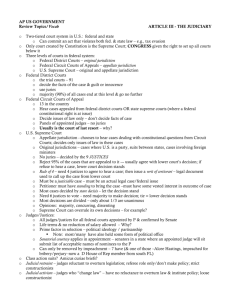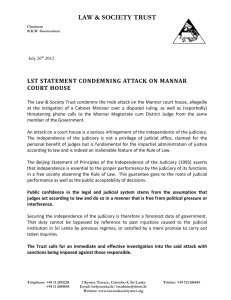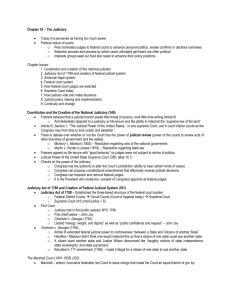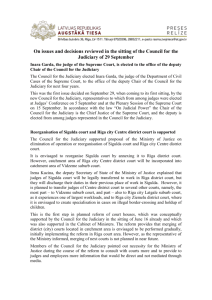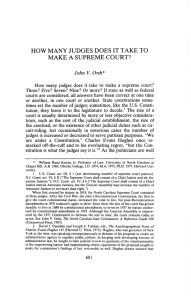Session 7 Judiciary
advertisement
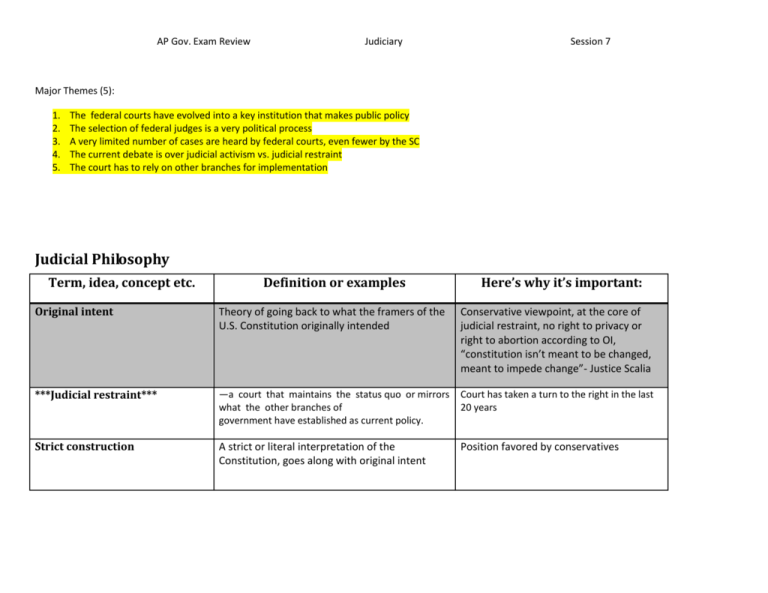
AP Gov. Exam Review Judiciary Session 7 Major Themes (5): 1. 2. 3. 4. 5. The federal courts have evolved into a key institution that makes public policy The selection of federal judges is a very political process A very limited number of cases are heard by federal courts, even fewer by the SC The current debate is over judicial activism vs. judicial restraint The court has to rely on other branches for implementation Judicial Philosophy Term, idea, concept etc. Definition or examples Here’s why it’s important: Original intent Theory of going back to what the framers of the U.S. Constitution originally intended Conservative viewpoint, at the core of judicial restraint, no right to privacy or right to abortion according to OI, “constitution isn’t meant to be changed, meant to impede change”- Justice Scalia ***Judicial restraint*** —a court that maintains the status quo or mirrors what the other branches of government have established as current policy. Court has taken a turn to the right in the last 20 years Strict construction A strict or literal interpretation of the Constitution, goes along with original intent Position favored by conservatives AP Gov. Exam Review ***Judicial activism*** Judiciary Session 7 —a philosophy of judicial review that results in decisions that overturn precedent. Judging what the Constitution meant according to the times. culture, background of judges Controversial. Judges seen as “legislating from the bench” Going beyond the Constitution to make radical changes based on what judges see fit. Favored by liberals. Dominated the Warren Court Dual court system Federal and state court systems. All paths can lead to the U.S. Supreme Court. Footprint of federalism on the judicial branch. Trial courts Courts of original jurisdiction. Lowest level. Most cases are plea bargained and never go to trial. Original jurisdiction Courts where the case is heard for the first time. SC can have original jurisdiction in a few cases: states suing other states, citizen of one state suing another state, suit against the federal government, ambassadors Appellate jurisdiction Weakness of the court. Cases have to be Weakness of the court. Keeps the court in brought to the Court rather than the Court going check by limiting its power. SC can have out and finding cases. original jurisdiction in a few cases. Don’t review facts but to see if there are legal issues involved Structure of Court AP Gov. Exam Review Judiciary Session 7 District Courts 94 nation wide. first step in going up the ladder to the supreme court. Circuit Courts 13 of these. only has appellate jurisdiction. 2nd step on the way to the supreme court. Justiciable disputes Case must be settled on a basis of law rather than policy. If it can be solved in the legislative body (policy) that it doesn’t belong in the courts Standing to sue Parties or plaintiffs must have a serious interest in a case. Must prove substantial injury. Class action lawsuits Lawsuits permitting a small number of people to sue on half of other people similarly situated Makes it easier for “the little guy” Only federal courts where trials are held The Supreme Court (3 eras) 1789 to 1861- National supremancy and slavery. Four major cases from this era. Marbury, McCulloch, Gibbons and Dred. Where did ultimate power in the United States lie, the state or the national government? 1865 to 1936- Governemnt and the economy, dominant issue is how would the economy be regulated. States or national government? Upheld use of injunctions, etc. some safety regulations. Conservative period. 1936 to present- Government and political liberty. Court now defers to the legislature for the economy. Really takes off with Warren Court. Move to the right within the past 15-20 years. Federalist No. 78 Madison- the courts are the least dangerous branch to liberty. they have neither the sword nor the purse. argues in favor of lifetime appointments. Judges and SC justices are supposed to be above politics and have the freedom to make legally correct, but possibly unpopular decisions, i.e. Brown v. Board AP Gov. Exam Review Judiciary Session 7 “Rule of Four” Four out of the nine justices must agree to hear a case Majority opinion The statement of legal reasoning of the majority of justices deciding in a case Concurring opinion Those who support the majority opinion, but not necessarily for the same reason Dissenting opinion Those who disagree with the majority opinion Solicitor General The government’s attorney before the Supreme Court. Sometimes referred to as the “10th justice” Political questions Doctrine developed by the federal courts to avoid deciding some cases, principally conflicts between the congress and president Refer to Federalist No. 78. Independent judiciary Statutory construction Ability of the court to strike down parts of laws (statutes) In some cases where statutory construction in an issue, Congress passes new legislation to clarify an existing law Judicial implementation See Federalist No. 78 This is the courts greatest weakness. It must rely on the other two branches. See Brown v. Board. Ike had to call out the National Guard to enforce the court’s decision to integrate Central High School Precedent Prevents a “tyranny of the majority” on the SC AP Gov. Exam Review Judiciary Session 7 Appointment Process and Politics of the Court Senatorial courtesy Unwritten tradition that gives a Senator the ability to block a federal judge in their state Lower Court judges. Not SC. Doesn’t need written documentation. Appointment process Judiciary committee Appointed by president and confirmed by the Senate for both lower and Supreme Court Justices. VERY political. After failed Bork confirmation of ’87, nominees tread carefully before the Senate Judiciary Committee “Litmus test” Asking a judge where they stand on a particular issue (abortion, affirmative action, gun control etc.) before they are confirmed by the Senate Judges are prone to downplay their personal views and past decisions when being confirmed. Once confirmed, they have more freedom on the bench. Vetting process Pres. will create a “short list” of nominees for the bench when a vacancy opens, a justice retires or dies Names often leaked to see what kind of reaction there is (trial balloon) some names are vetted and don’t make it. Harriet Myers in 2005. Collegial Court concept The court operates professionally on their cases. Justices don’t speak out against one another in public. Dissents are written carefully with clear rhetoric rather than personal attacks against justices. AP Gov. Exam Review Judiciary Session 7 Latin 101 Amicus curiae briefs “Friend of the court” briefings. Third parties can file briefs on behalf of a plaintiff. Outside information. Often times the SC looks at numerous amicus briefs filed for a case. Expert opinion. Stare decisis Let the decision stand Most justices will not overturn precedent on the bench. key factor in confirmation process: adhering to precedent Writ of certiorari Ability of the SC to call up a case from a lower court. Mainly legal issues. Not the facts of a case. Justices hold cert conferences to go over the petitions from the parties involved in lower court cases. Kind of like a fastrack Writ of mandamus Compels a public official to perform a ministerial act to perform mandatory duties correctly Often a distractor answer Four Most Recent Supreme Courts Court and Years Warren- 1953 to 1969 Activist or Restraint? Very activist. Liberal court. Break from the past Rights of criminal defendants Personal liberties Landmark cases The Big Six: Miranda Gideon Mapp Engel Gideon Griswold AP Gov. Exam Review Judiciary Session 7 Burger- 1960 to 1986 Burger more conservative but court hands down the most “activist” ruling in the eyes of conservatives, Roe v. Wade Roe Craig v. Boren N.Y. Times v. U.S. U.C. Davis v. Bakke Rhenquist- 1986 to 2005 Restraint. Rhenquist argued for a return of power to the states under th the 10 amendment U.S. v. Lopez Roberts- 2005 to present Restraint. Conservative and liberal split with one moderate. Roberts confirmed as a moderate but critics argue he cloaked his conservative credentials during confirmation Kelo v. City of New London Citizens United v. FEC


